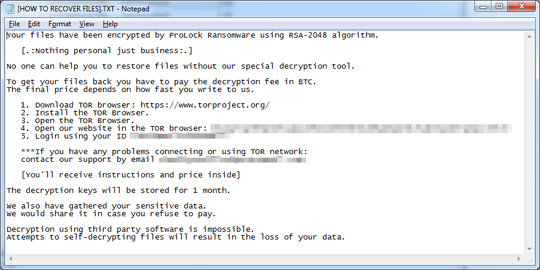Ransom.PS1.PROLOCK.AA
PwrSh:PowerSploit-D [Trj] (AVAST)
Windows


Threat Type: Ransomware
Destructiveness: No
Encrypted: No
In the wild: Yes
OVERVIEW
Downloaded from the Internet, Dropped by other malware
This Ransomware arrives on a system as a file dropped by other malware or as a file downloaded unknowingly by users when visiting malicious sites.
It drops files as ransom note. It avoids encrypting files with the following file extensions.
TECHNICAL DETAILS
2,720 bytes
No
19 Mar 2020
Terminates processes, Displays message/message boxes, Encrypts files
Arrival Details
This Ransomware arrives on a system as a file dropped by other malware or as a file downloaded unknowingly by users when visiting malicious sites.
Installation
This Ransomware adds the following processes:
- vssadmin.exe resize shadowstorage /for={Drive Letter}: /on={Drive Letter}: /maxsize=401MB → resizes the maximum amount of storage space that can be used for shadow copy storage
- vssadmin.exe resize shadowstorage /for={Drive Letter}: /on={Drive Letter}: /maxsize=unbounded → resizes the maximum amount of storage space that can be used for shadow copy storage
- vssadmin.exe delete shadows /all /quiet → deletes shadow copies
Process Termination
This Ransomware terminates the following services if found on the affected system:
- Acronis VSS Provider
- AcronisAgent
- Alerter
- BackupExecAgentAccelerator
- BackupExecDeviceMediaService
- BackupExecJobEngine
- BackupExecManagementService
- BackupExecRPCService
- BackupExecVSSProvider
- BASupportExpressSrvcUpdater_N_Central
- BASupportExpressStandaloneService_N_Central
- bbagent
- CSFalconService
- DFSR
- epag
- EPIntegrationService
- EPProtectedService
- epredline
- EPSecurityService
- EPUpdateService
- EqlReqService
- EqlVss
- hasplms
- macmnsvc
- masvc
- MB3Service
- MBAMService
- MBEndpointAgent
- McAfeeDLPAgentService
- McAfeeFramework
- mfemms
- mozyprobackup
- MsDtsServer
- MSExchangeADTopology
- MSExchangeDelivery
- MSExchangeDiagnostics
- MSExchangeEdgeSync
- MSExchangeES
- MSExchangeHM
- MSExchangeHMRecovery
- MSExchangeIS
- MSExchangeMailboxReplication
- MSExchangeMGMT
- MSExchangeMTA
- MSExchangeRepl
- MSExchangeRPC
- MSExchangeSA
- MSExchangeServiceHost
- MSExchangeSRS
- MSExchangeTransport
- MSExchangeUM
- MSExchangeUMCR
- MSMQ
- MSOLAP$*
- MSOLAP$SQL_2008
- MSOLAP$SYSTEM_BGC
- MSOLAP$TPS
- MSOLAP$TPSAMA
- MSSQL$*
- MSSQL$BKUPEXEC
- MSSQL$ECWDB2
- MSSQL$PRACTICEMGT
- MSSQL$PRACTTICEBGC
- MSSQL$PROD
- MSSQL$PROFXENGAGEMENT
- MSSQL$SBSMONITORING
- MSSQL$SHAREPOINT
- MSSQL$SOPHOS
- MSSQL$SQL_2008
- MSSQL$SQLEXPRESS
- MSSQL$SYSTEM_BGC
- MSSQL$TPS
- MSSQL$TPSAMA
- MSSQL$VEEAMSQL2008R2
- MSSQL$VEEAMSQL2012
- MSSQLFDLauncher
- MSSQLFDLauncher$PROFXENGAGEMENT
- MSSQLFDLauncher$SBSMONITORING
- MSSQLFDLauncher$SHAREPOINT
- MSSQLFDLauncher$SQL_2008
- MSSQLFDLauncher$SYSTEM_BGC
- MSSQLFDLauncher$TPS
- MSSQLFDLauncher$TPSAMA
- MSSQLSERVER
- MSSQLServerADHelper
- MSSQLServerADHelper100
- MSSQLServerOLAPService
- MySQL57
- NasPmService
- OracleClientCache80
- OSearch15
- psqlWGE
- QuickBooksDB25
- RapidRecoveryAgent
- ReportServer
- ReportServer$*
- ReportServer$SQL_2008
- ReportServer$SYSTEM_BGC
- ReportServer$TPS
- ReportServer$TPSAMA
- SPAdminV4
- SPSearchHostController
- SPTraceV4
- SPUserCodeV4
- SPWriterV4
- SQLAgent$*
- SQLAgent$BKUPEXEC
- SQLAgent$CITRIX_METAFRAME
- SQLAgent$CXDB
- SQLAgent$ECWDB2
- SQLAgent$PRACTTICEBGC
- SQLAgent$PRACTTICEMGT
- SQLAgent$PROD
- SQLAgent$PROFXENGAGEMENT
- SQLAgent$SBSMONITORING
- SQLAgent$SHAREPOINT
- SQLAgent$SOPHOS
- SQLAgent$SQL_2008
- SQLAgent$SQLEXPRESS
- SQLAgent$SYSTEM_BGC
- SQLAgent$TPS
- SQLAgent$TPSAMA
- SQLAgent$VEEAMSQL2008R2
- SQLAgent$VEEAMSQL2012
- SQLBackupAgent
- SQLBackups
- SQLBrowser
- SQLsafe Backup Service
- SQLSafeOLRService
- SQLSERVERAGENT
- SQLTELEMETRY
- SQLWriter
- stc_endpt_svc
- swprv
- Symantec System Recovery
- SyncoveryVSSService
- TeamViewer
- TMBMServer
- tmccsf
- tmlisten
- Veeam Backup Catalog Data Service
- VeeamBackupSvc
- VeeamCatalogSvc
- VeeamCloudSvc
- VeeamEndpointBackupSvc
- VeeamEnterpriseManagerSvc
- VeeamMountSvc
- VeeamNFSSvc
- VeeamRESTSvc
- VeeamTransportSvc
- vhdsvc
- VSNAPVSS
- wbengine
- WinVNC4
- wsbexchange
- YTBackup
Other Details
This Ransomware does the following:
- It requires the following file in order to execute its malicious routines properly:
- C:\Programdata\WinMgr.bmp → Detected as Ransom.Win32.PROLOCK.AA
- It avoids encrypting files that are below 8KB in size.
Ransomware Routine
This Ransomware avoids encrypting files found in the following folders:
- $Recycle.Bin
- All Users
- Boot
- Common Files
- DVD Maker
- Internet Explorer
- Kaspersky Lab
- Kaspersky Lab Setup Files
- Microsoft
- Microsoft.NET
- Microsoft_Corporation
- Mozilla Firefox
- PerfLog
- System Volume Information
- Uninstall Information
- Windows
- Windows Defender
- Windows Mail
- Windows Media Player
- Windows NT
- Windows Photo Viewer
- Windows Portable Devices
- Windows Sidebar
- WindowsApps
- WindowsPowerShell
It appends the following extension to the file name of the encrypted files:
- .proLock
It drops the following file(s) as ransom note:
- {Encrypted Directory}\[HOW TO RECOVER FILES].TXT

It avoids encrypting files with the following file extensions:
- .bac
- .bak
- .bat
- .bkf
- .chm
- .cmd
- .dll
- .dsk
- .exe
- .hlf
- .ico
- .inf
- .ini
- .lng
- .lnk
- .msi
- .set
- .sys
- .ttf
- .vhd
- .wbc
- .win
SOLUTION
9.850
15.752.04
19 Mar 2020
15.753.00
20 Mar 2020
Step 1
Before doing any scans, Windows 7, Windows 8, Windows 8.1, and Windows 10 users must disable System Restore to allow full scanning of their computers.
Step 2
Note that not all files, folders, and registry keys and entries are installed on your computer during this malware's/spyware's/grayware's execution. This may be due to incomplete installation or other operating system conditions. If you do not find the same files/folders/registry information, please proceed to the next step.
Step 3
Identify and terminate files detected as Ransom.PS1.PROLOCK.AA
- Windows Task Manager may not display all running processes. In this case, please use a third-party process viewer, preferably Process Explorer, to terminate the malware/grayware/spyware file. You may download the said tool here.
- If the detected file is displayed in either Windows Task Manager or Process Explorer but you cannot delete it, restart your computer in safe mode. To do this, refer to this link for the complete steps.
- If the detected file is not displayed in either Windows Task Manager or Process Explorer, continue doing the next steps.
Step 4
Search and delete this file
- {Encrypted Directory}\\[HOW TO RECOVER FILES].TXT
Step 5
Scan your computer with your Trend Micro product to delete files detected as Ransom.PS1.PROLOCK.AA. If the detected files have already been cleaned, deleted, or quarantined by your Trend Micro product, no further step is required. You may opt to simply delete the quarantined files. Please check the following Trend Micro Support pages for more information:
Step 6
Restore encrypted files from backup.
Did this description help? Tell us how we did.

